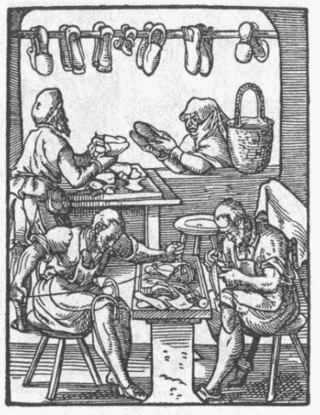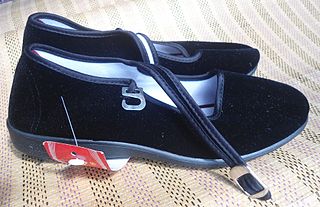
Slippers are a type of shoes falling under the broader category of light footwear, that are easy to put on and off and are intended to be worn indoors, particularly at home. [1] They provide comfort and protection for the feet when walking indoors.

Slippers are a type of shoes falling under the broader category of light footwear, that are easy to put on and off and are intended to be worn indoors, particularly at home. [1] They provide comfort and protection for the feet when walking indoors.
The recorded history of slippers can be traced back to the 12th century. [2] In the West, the record can only be traced to 1478. [3] [ better source needed ] [4] [ failed verification ] The English word "slippers" (sclyppers) occurs from about 1478. [5] English-speakers formerly also used the related term "pantofles" (from French pantoufle).

Slippers in China date from 4700 BCE; they were made of cotton or woven rush, had leather linings, and featured symbols of power, such as dragons. [6]
Native American moccasins were also highly decorative. Such moccasins depicted nature scenes and were embellished with beadwork and fringing; their soft sure-footedness made them suitable for indoors appropriation. Inuit and Aleut people made shoes from smoked hare-hide to protect their feet against the frozen ground inside their homes. [7]
Fashionable Orientalism saw the introduction into the West of designs like the baboosh.
Victorian people needed such shoes to keep the dust and gravel outside their homes. [8] For Victorian ladies slippers gave an opportunity to show off their needlepoint skills and to use embroidery as decoration. [9]
This section needs additional citations for verification .(June 2016) |
Types of slippers include:

Some slippers are made to resemble something other than a slipper and are sold as a novelty item. The slippers are usually made from soft and colorful materials and may come in the shapes of animals, animal paws, vehicles, cartoon characters, etc.
Not all shoes with a soft fluffy interior are slippers. Any shoe with a rubber sole and laces is a normal outdoor shoe. In India, rubber chappals (flip-flops) are worn as indoor shoes. [10]
The fictional character Cinderella is said to have worn glass slippers; in modern parlance, they would probably be called glass high heels. This motif was introduced in Charles Perrault's 1697 version of the fairy tale, "Cendrillon ou la petite pantoufle de verre" "Cinderella, or The Little Glass Slipper". For some years it was debated that this detail was a mistranslation and the slippers in the story were instead made of fur (French: vair), but this interpretation has since been discredited by folklorists. [11]
A pair of ruby slippers worn by Judy Garland in The Wizard of Oz sold at Christie's in June 1988 for $165,000. The same pair was resold on May 24, 2000, for $666,000. [12] On both occasions, they were the most expensive shoes from a film to be sold at auction. [13]
In Hawaii and many islands of The Caribbean, slippers, or "slippahs" is used for describing flip-flops. [14]
The term "house shoes" (elided into how-shuze) is common in the American South. [15]

A shoe is an item of footwear intended to protect and comfort the human foot. Though the human foot can adapt to varied terrains and climate conditions, it is vulnerable, and shoes provide protection. Form was originally tied to function, but over time, shoes also became fashion items. Some shoes are worn as safety equipment, such as steel-toe boots, which are required footwear at industrial worksites.

Footwear refers to garments worn on the feet, which typically serve the purpose of protection against adversities of the environment such as wear from rough ground; stability on slippery ground; and temperature.

A boot is a type of footwear. Most boots mainly cover the foot and the ankle, while some also cover some part of the lower calf. Some boots extend up the leg, sometimes as far as the knee or even the hip. Most boots have a heel that is clearly distinguishable from the rest of the sole, even if the two are made of one piece. Traditionally made of leather or rubber, modern boots are made from a variety of materials.

The ruby slippers are a pair of shoes worn by Dorothy Gale as played by Judy Garland in the 1939 Metro-Goldwyn-Mayer musical film The Wizard of Oz. Because of their iconic stature, they are among the most valuable items of film memorabilia. Several pairs were made for the film, though the exact number is unknown. Five pairs are known to have survived; one pair was stolen from a museum in 2005 and recovered in 2018.

A climbing shoe is a specialized type of footwear designed for rock climbing. Typical climbing shoes have a tight fit, an asymmetrical downturn, and a sticky rubber sole with an extended rubber rand to the heel and the toe. Different types of shoes can be better suited for different levels of technique and routes.

Flip-flops are a type of light sandal-like shoe, typically worn as a form of casual footwear. They consist of a flat sole held loosely on the foot by a Y-shaped strap known as a toe thong that passes between the first and second toes and around both sides of the foot. This style of footwear has been worn by people of many cultures throughout the world, originating as early as the ancient Egyptians in 1500 BC. In the United States the modern flip-flop may have had its design taken from the traditional Japanese zōri, after World War II as soldiers brought them back from Japan.

Zori, also rendered as zōri, are thonged Japanese sandals made of rice straw, cloth, lacquered wood, leather, rubber, or—most commonly and informally—synthetic materials. They are a slip-on descendant of the tied-on waraji sandal.

Sandals are an open type of shoe, consisting of a sole held to the wearer's foot by straps going over the instep and around the ankle. Sandals can also have a heel. While the distinction between sandals and other types of footwear can sometimes be blurry, the common understanding is that a sandal leaves all or most of the foot exposed. People may choose to wear sandals for several reasons, among them comfort in warm weather, economy, and as a fashion choice. Usually, people wear sandals in warmer climates or during warmer parts of the year in order to keep their feet cool and dry. The risk of developing athlete's foot is lower than with enclosed shoes, and the wearing of sandals may be part of the treatment regimen for such an infection.

Shoemaking is the process of making footwear.

Opanci are traditional peasant shoes worn in Southeastern Europe. The attributes of the opanci are a construction of leather, lack of laces, durable, and various endings on toes. In Serbia, the design of the horn-like ending on toes indicates the region of origin, though this specific design is not exclusive to Serbia. The opanci are also considered as the traditional peasant footwear for people in the Balkan region. In Bulgaria they are referred to as "tsarvuli".

Galoshes, also known by many other names, are a type of overshoe or rubber boot that is put on over shoes to keep them from getting muddy or wet during inclement weather.

The Papal slippers are a historical accoutrement worn by the Pope. The papal slippers were a form of episcopal sandals worn by bishops. However, unlike the episcopal sandals, which change with the liturgical colour, the papal slippers were always red.

A court shoe or pump is a shoe with a low-cut front, or vamp, with either a shoe buckle or a black bow as ostensible fastening. Deriving from the 17th- and 18th-century dress shoes with shoe buckles, the vamped pump shape emerged in the late 18th century. By the turn of the 19th century, shoe buckles were increasingly replaced by black bows, which has remained the contemporary style for men's formal wear, leather or patent leather evening pumps ever since. This latter style is sometimes also called an opera pump or opera slipper.

A moccasin is a shoe, made of deerskin or other soft leather, consisting of a sole and sides made of one piece of leather, stitched together at the top, and sometimes with a vamp. The sole is soft and flexible and the upper part often is adorned with embroidery or beading. Though sometimes worn inside, it is chiefly intended for outdoor use.

A dress shoe is a shoe to be worn at smart casual or more formal events. A dress shoe is typically contrasted to an athletic shoe.
Cavalier boots are a style of boot that were popular in Europe between approximately 1500 and 1700. They are soft knee-high leather boots typically made of brown calfskin.

Dress boots are short leather boots typically worn by men. Built like dress shoes, but with uppers covering the ankle, versions of the boots are used as an alternative to these in bad weather or rough outdoor situation, and as a traditional option for day time formalwear.
The Peshawari chappal is a traditional type of footwear of Pashtuns, worn especially by Pashtuns in the Khyber Pakhtunkhwa region. The shoe takes its name from the city of Peshawar, where it originates. While chappal is the word for flip-flops or sandals in Urdu, locals in Peshawar call the Peshawari Tsaplay. The shoes are worn by men casually or formally, usually with the shalwar kameez. Because of their comfort, they are worn in place of sandals or slippers in Pakistan.

The kung fu shoe, also known as a "tai chi shoe" or as a "martial arts slipper", is a type and style of cloth slip-on shoe that is traditionally made in China, and was originally worn while practicing kung fu and other martial arts, and also while performing tai chi.
Ancient Athenians imported Laconian slippers from Sparta or Asian slip-ons from Persia. [...] Roman women wore socci (slippers) indoors and for assignations. [...] After 449, Anglo-Saxon grooms received their brides' 'slype-scoes' (slip-shoes) from their fathers-in-law as symbols of protection and female control. [...] Trends continued to offer new sensations, as with the Italian pianella (wedge mule) and the scarpetta (slipper) of the late 1300s made in the same fabric as an ensemble. In contrast to the stride of the booted male, women adjusted their gait to suit the slipper, an emblem of femininity.
The earliest recorded reference to the slipper was is[sic] in the 12th Century by a Southern Song Dynasty Officer where he describes two types of slipper he saw in what is now Vietnam. [...] In the West, slippers were first recorded around 1478.
In China as early as 4700 B.C.E,, court robes and cotton or woven rush slippers sported leather linings and embroidered dragon-and-phoenix designs as emblems of power.
Inuit and Aleut people would make shoes from smoked hare hide to protect their feet against the frozen ground inside their homes.
[...] the discerning Victorian gentleman was in need of a pair of 'house shoes' in order to keep the dust and gravel outside – much better than ruining his expensive rug and beautifully polished floor.
Embroidered slippers presented Victorian ladies (on both sides of the Atlantic) with an opportunity to show off their needlepoint skills.